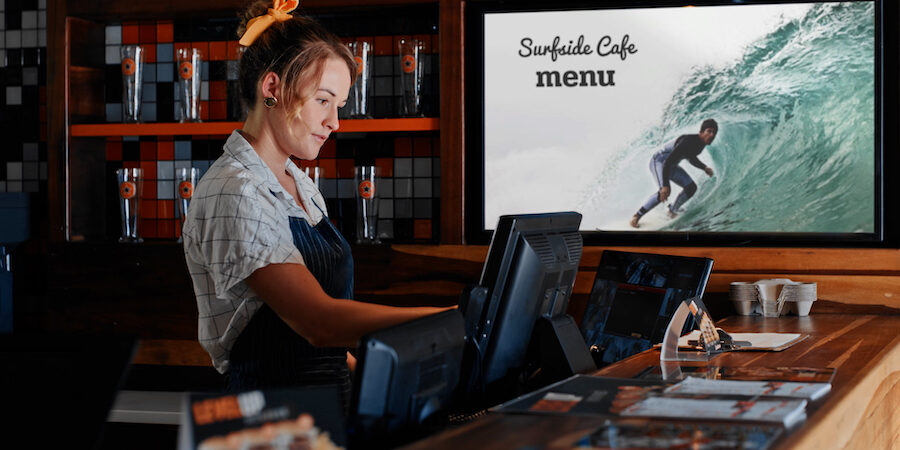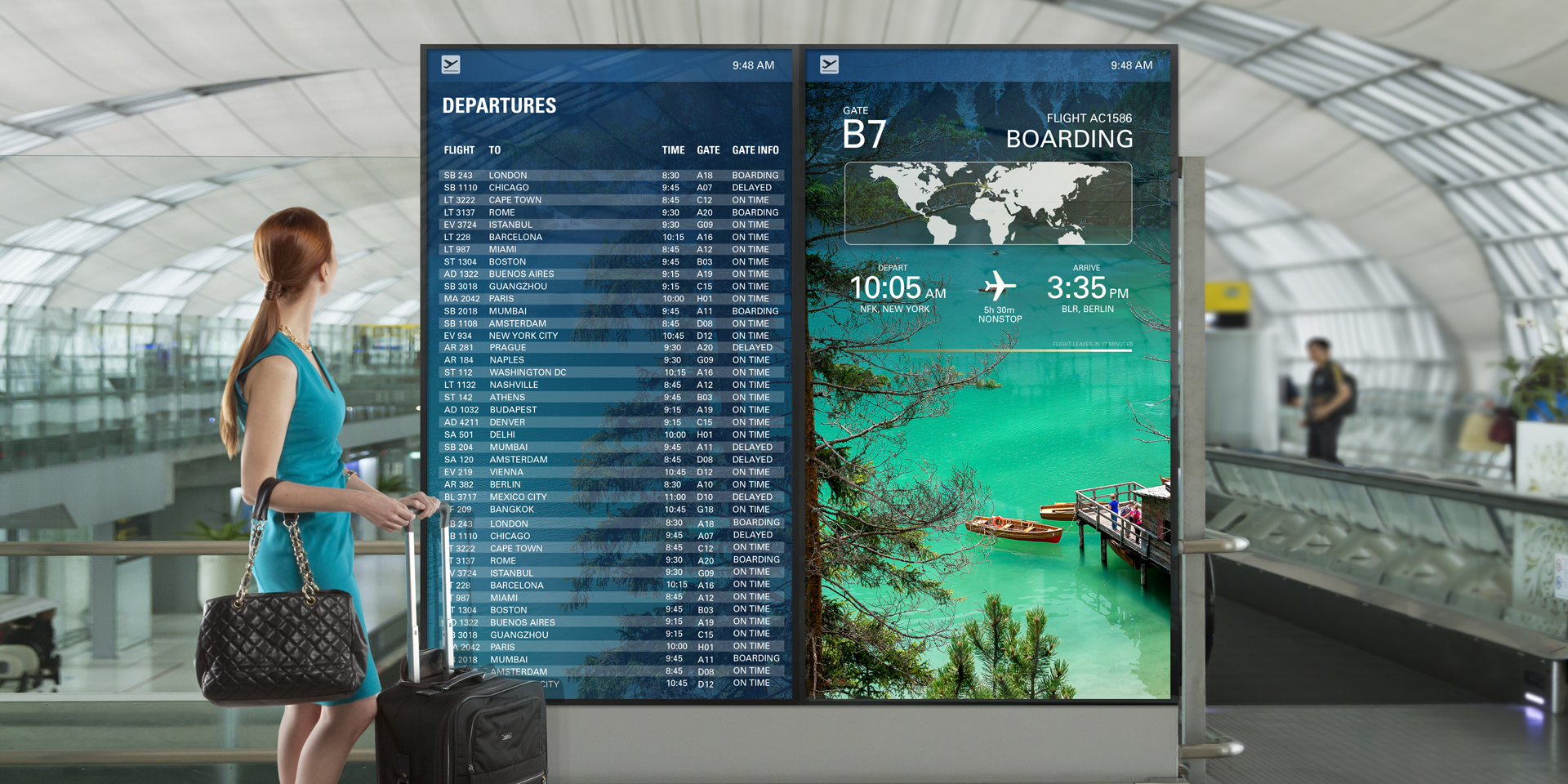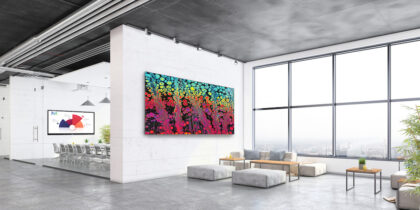This is part one of our look at the why and how of using an enterprise content management system (CMS) with a digital signage network. Read part two for insights into choosing the best CMS for your display strategy.
While it’s possible to run a digital display from a USB drive, the capabilities are limited. To maximize efficiency and effectiveness, a sophisticated network requires a content management system. An enterprise CMS enables managers and IT staff to develop, organize, target, schedule and distribute content quickly, easily and remotely, while also providing monitoring tools to track performance. As digital display use becomes more widespread, content must stay competitive, making a CMS an essential tool for businesses today.
Standing out in your market starts with understanding what a CMS is and how it can benefit your business and signage network.
What is a reliable content management system?
An enterprise CMS is a software solution that manages, stores, organizes and schedules digital display content. It simplifies operations by centralizing control, making it much easier to manage a single system than to rely on multiple USB drives or other storage devices. Integrated scheduling tools ensure the right content is delivered at the right time for maximum impact. Centralized management also allows any internet-connected device to serve as the control board from any location.
Digital signage content management made easy
Get your complete guide to configuring and tailoring real-time messaging using an integrated CMS. Download Now
Samsung VXT CMS does all this and more, with extensive scheduling options, including nested playlists and global tagging to make organizing content more efficient. The enhanced VXT makes managing large-scale deployments easier, with multiscreen enrollment and increased backlight control, which ensures optimal display performance across multiple locations. It also offers creative support with a variety of templates, free stock images and widgets for visually engaging content. Additionally, this CMS provides custom home screen design, allowing users to personalize branding and edit Info Cards to display key information at a glance. AI-powered image generation and advanced widget integrations allow for further customization. Content Preview adds a quality control layer by letting users verify content before pushing it live, ensuring accurate displays across different hardware configurations. Advanced remote management functionality enables users to secure, monitor and proactively manage displays from anywhere.
All these features make the enhanced VXT CMS a polished, professional digital signage solution compatible with a wide range of hardware, including Samsung Smart Signage, Windows and Android.
Author, update and broadcast content on a single platform
A CMS provides essential file upload capabilities and storage for images and videos. More advanced platforms, such as Samsung VXT, go beyond this by offering content authoring tools that allow users to build media from scratch or use the preloaded templates to fast-track their designs.
Samsung VXT incorporates HTML5, the latest web presentation technology, enabling automatic updates for numbers, charts and images based on specified data triggers. The automation reduces costs significantly … and saves time.
To keep displays fresh and engaging with minimal effort, VXT integrates third-party content feeds, including news, weather and sports scores. The latest TWC Weather Widget updates weather information automatically based on screen location, while Instagram support boosts audience engagement. Additionally, users can generate custom visuals with GenAI-based image creation via VXT Canvas. Link My POS is a POS-integrated menu board solution for VXT that seamlessly pulls product data from the point-of-sale system, eliminating the need for manual entry.
Samsung VXT also supports multichannel content distribution, delivering different information streams across multiple screens within a single location or across branches. The Screen Wall feature ensures synchronized content playback on video walls and multiscreen setups, while Takeover Sync Play enables seamless transitions between content streams — even mid-playback — maximizing advertising impact and audience engagement. The Seenspire PIRS app offers a diverse selection of curated content feeds designed to inform and engage audiences, ensuring displays stay fresh and captivating with minimal effort. This keeps everyone on the same page while letting users customize their networks.
Stingray Music, available across Canada and the United States only, also provides businesses with access to a wide range of curated music channels, allowing seamless integration into digital signage systems to enhance customer experiences with high-quality background music.
Management ranges from simple to complex
A robust enterprise CMS like Samsung VXT can be managed effectively at every level, whether at a single business location or a chain with hundreds of branches. It also allows you to differentiate, so it’s easy to tailor content for businesses operating across multiple time zones or demographic areas. A rural bank, for example, may require content in only one language, while branches in urban areas may need multilingual support. VXT allows businesses to schedule content based on location, time or real-time data triggers, so you have the flexibility to update and personalize content dynamically.
For more precise content control, VXT presents Global and Essential Tags, which maintain consistent tagging across all screens and workspaces. The new Favorites-Based Browsing feature makes it easier to track frequently used tags, screens and playlists, helping you organize content more efficiently.
Managing all this manually would be a full-time job for one person or more, especially as content volume and complexity grow — which also increases the potential for human error. A CMS that uses data tags to describe attributes and conditions permits fast, accurate and largely automated scheduling. Along with organizing, scheduling, targeting and distributing content, a display CMS like Samsung VXT can validate materials and archive old or expired files that take up valuable storage space. This CMS goes a step further with board-style summary views that analyze display content performance and identify opportunities for improvement.
Finally, the Samsung VXT Event Manager helps automate scheduling by allowing users to set up event-triggered content based on time, network, SmartThings sensors or touch interactions. That automation reduces human involvement while ensuring timely and relevant content delivery.
It’s a unified solution for every need
Even the best display content can fail if the system managing it is inefficient or lacks essential tools. That’s why a great CMS should include the right tools to keep it running, including:
- Remote management: A fully capable CMS includes robust device monitoring to track display performance and notify users of issues. In this case, Samsung enhanced VXT offers comprehensive monitoring and troubleshooting, ensuring smoother operation and fewer repairs. Administrators can control access based on user roles, streamlining deployment and ensuring only authorized personnel can make changes. VXT Enterprise Plan – X Series further enhances system reliability with proactive monitoring. VXT X Series and P Series offer an Early Warning Report and Weekly Reboots to maintain system health and prevent potential failures. When you need support, all plans (including S Series, P Series and X Series) provide live chat and chatbot functionality to help resolve issues.
- Network integrity and security: As digital signage gets more connected, security is a top priority. Internet- or cloud-connected devices are vulnerable to hacking and cyberattacks that can cause service disruptions, compromise data and damage a brand’s reputation. A CMS should meet the International Organization for Standardization certification for information security — the digital signage industry’s highest level. VXT exceeds this by offering a screen monitoring lock, which restricts remote access and protects confidential content in sensitive environments like corporate boardrooms. Samsung also purposefully sought ISO 27001 and ISO 27701 certifications to provide industry-leading security for its CMS, including secure login procedures, data encryption and access control when connecting to external systems, and access control for content stored on the server.
- Redundancy: Hybrid cloud content management solutions offer advantages by combining the scalability and flexibility of the cloud with the control and security of on-premises infrastructure. This approach allows businesses to store sensitive data on private servers while leveraging the cloud for other content. Additionally, it enables enhanced data redundancy, improving overall system reliability. Samsung VXT plans to provide hybrid cloud servers for specific verticals that cannot use the cloud or require a balance of on-premises control and cloud flexibility, ensuring they can meet regulatory or security requirements while benefiting from modern cloud capabilities.
- Scalability: A CMS should support large-scale deployments and real-time updates. Systems that process only a few updates at a time can take hours to distribute critical changes across an entire network. This becomes especially important for large video walls made up of multiple displays. Here, Samsung VXT ensures seamless content flow with Sync Play and Screen Wall, orchestrating playback across multiple screens. It also offers better large video-wall synchronization, adding more preset options and enabling direct firmware updates, helping you easily scale and keep your network up to date.
With these innovations, Samsung VXT provides a powerful, AI-enhanced and highly secure CMS solution for businesses of all sizes.
The benefits of a robust CMS like Samsung VXT are clear. So, how do you choose the right one for your business? Read part two to explore selecting the best CMS for your display strategy.
Get started today with Samsung VXT to control your digital signage seamlessly. Also, learn more about how hybrid cloud-based platforms enable automation, scalability — and commercial success.








